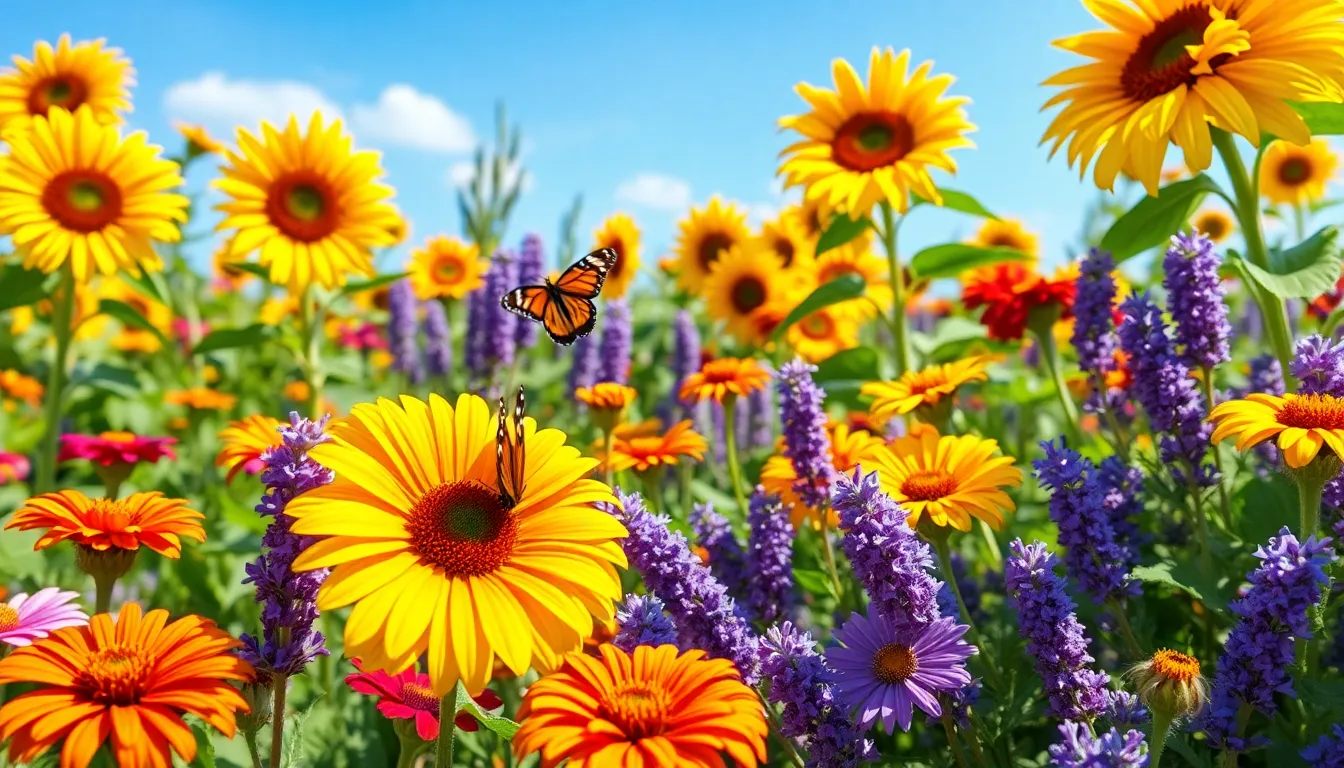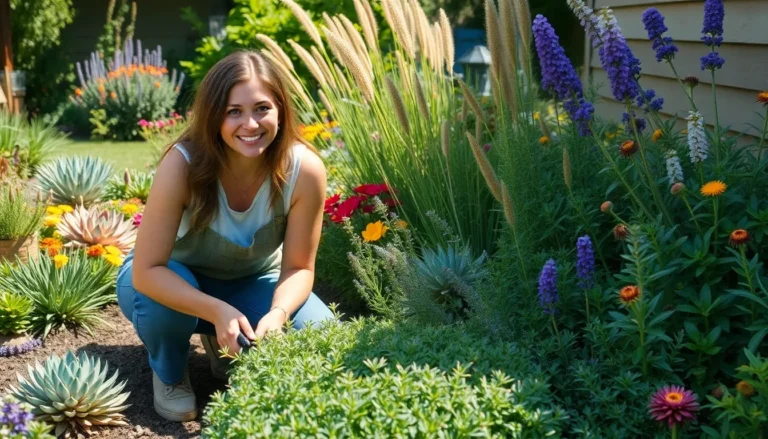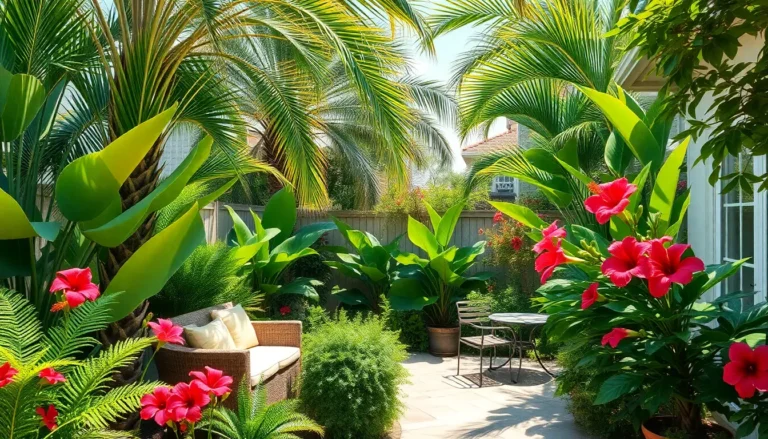When it comes to outdoor gardening, not all plants are created equal. Some thrive in the glorious embrace of full sun while others wilt faster than a snowman in July. If you’ve ever found yourself staring at a patch of sun-soaked soil wondering what to plant, you’re in for a treat. Full sun plants are the superheroes of the garden world, ready to soak up those rays and transform your outdoor space into a vibrant oasis.
Full Sun Plants Outdoor
Full sun plants thrive in bright, direct sunlight for at least six hours each day. These plants adapt well to environments that receive abundant sunshine, making them ideal for gardens, landscapes, and outdoor spaces. Popular choices include tomatoes, sunflowers, lavender, and zinnias. Each of these plants demonstrates resilience and vibrant growth, showcasing colorful blooms or fruitful yields.
Moreover, selecting full sun plants contributes to water efficiency. Many sun-loving species develop robust root systems, enabling them to access nutrients while requiring less water over time. Additionally, these plants often exhibit increased tolerance to heat, which enhances their durability during warmer months.
Gardening enthusiasts appreciate full sun plants for their aesthetic appeal. Garden beds filled with these species create striking color palettes that attract pollinators, such as butterflies and bees. Pollinators play a critical role in maintaining ecological balance, making full sun gardens both beautiful and beneficial.
When planning a full sun garden, consider the soil conditions and climate of the region. Some plants prefer well-draining soil, while others may thrive in a mix of sandy and clay substrates. Matching the right plants to the specific conditions ensures healthier growth and longevity.
Incorporating a variety of full sun plants adds depth and texture to outdoor spaces. Adding a mix of heights, colors, and foliage types enriches the overall garden design. Various combinations not only elevate visual interest but also create microhabitats that support diverse wildlife.
Benefits of Full Sun Plants

Full sun plants offer numerous advantages for outdoor gardening that enhance garden aesthetics and ecological health.
Improved Growth and Bloom
Full sun conditions promote robust growth, allowing plants like tomatoes and sunflowers to thrive. Bright sunlight fuels photosynthesis, which directly impacts plant health and flowering. Many plants in sunny areas develop stronger structures, making them less susceptible to pests and diseases. Healthy roots access water and nutrients more efficiently, leading to increased flowering and fruiting. Examples like lavender and zinnias showcase vibrant blooms that flourish in these conditions. Regular exposure to sunlight contributes to longer blooming periods, making gardens visually appealing throughout the seasons.
Attracting Pollinators
Full sun plants play a crucial role in attracting pollinators, which are essential for ecosystem health. Colorful blooms in direct sunlight draw bees, butterflies, and other beneficial insects. Diverse flower shapes and sizes cater to various pollinator preferences. For instance, sunflowers provide not only visual interest but also abundant pollen and nectar. Increased pollinator activity boosts the chances of successful fertilization, leading to more abundant fruit and seed production. By incorporating full sun plants, gardeners enhance biodiversity, benefiting both their gardens and the surrounding environment.
Popular Full Sun Plants
Numerous plants thrive under bright sunlight, making them perfect for outdoor gardens. Each category—annuals, perennials, shrubs, and trees—offers unique benefits.
Annuals for Full Sun
Annuals provide a vibrant splash of color, flourishing throughout the growing season. Marigolds stand out with their bright orange and yellow flowers, attracting beneficial insects. Petunias show off their striking blooms, making them a popular choice among gardeners. Zinnias offer long-lasting flowers in various hues, ideal for cutting gardens. These plants typically require minimal maintenance and provide continuous blooms, enhancing garden aesthetics.
Perennials for Full Sun
Perennials deliver beauty year after year, creating a lasting presence in gardens. Black-eyed Susans thrive in sunny spots, showcasing their cheerful yellow petals. Lavender not only looks stunning but also emits a lovely fragrance, appealing to both gardeners and pollinators. Coneflowers, known for their resilience, attract butterflies and bees, contributing to ecological health. Choosing these perennials ensures a vibrant garden with minimal replanting.
Shrubs and Trees for Full Sun
Shrubs and trees contribute structure and height to outdoor spaces while thriving in the sun. Butterfly bushes, recognized for attracting butterflies, provide vibrant blooms that enhance any landscape. Crape myrtles add striking colors during summer months, making them a favored choice for visual interest. Moreover, holly offers year-round greenery while producing red berries that attract wildlife. Selecting hardy options in this category ensures a visually appealing and eco-friendly garden.
Tips for Growing Full Sun Plants
Growing full sun plants requires careful attention to soil and watering methods. Proper soil preparation enhances plant growth and resilience.
Soil Preparation and Drainage
Select well-draining soil for full sun plants. Mix organic matter like compost or peat moss into the soil to boost nutrients. Maintain a pH level between 6.0 and 7.0, supporting optimal growth conditions. Avoid clay-heavy soils, which can retain excessive moisture. Raised beds or mounds can improve drainage, preventing root rot. Incorporating mulch helps retain moisture and regulate soil temperature. Ensure that the planting area receives ample sunlight throughout the day to maximize growth potential.
Watering Techniques
Implement consistent watering practices to promote growth. Water deeply but less frequently, allowing the soil to dry out between sessions. Early morning serves as the ideal time for watering, reducing evaporation and fungal risks. Check soil moisture before watering, ensuring that it’s dry several inches below the surface. Use a soaker hose or drip irrigation system for efficient water distribution. Full sun plants thrive with established watering routines, helping them withstand drought conditions and promoting robust development.
Conclusion
Choosing full sun plants for outdoor gardens not only enhances visual appeal but also supports a thriving ecosystem. These resilient plants adapt well to sunny conditions and require less water over time, making them a practical choice for gardeners. By incorporating a variety of species, one can create a vibrant landscape that attracts pollinators and promotes biodiversity.
With proper soil preparation and watering techniques, full sun plants can flourish and provide lasting beauty throughout the seasons. Embracing these hardy options ensures a garden that is both stunning and beneficial to the environment.





